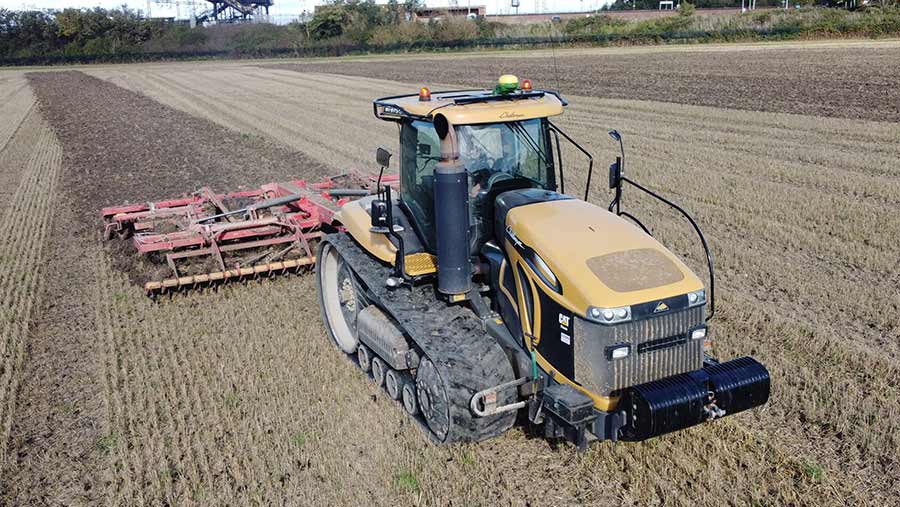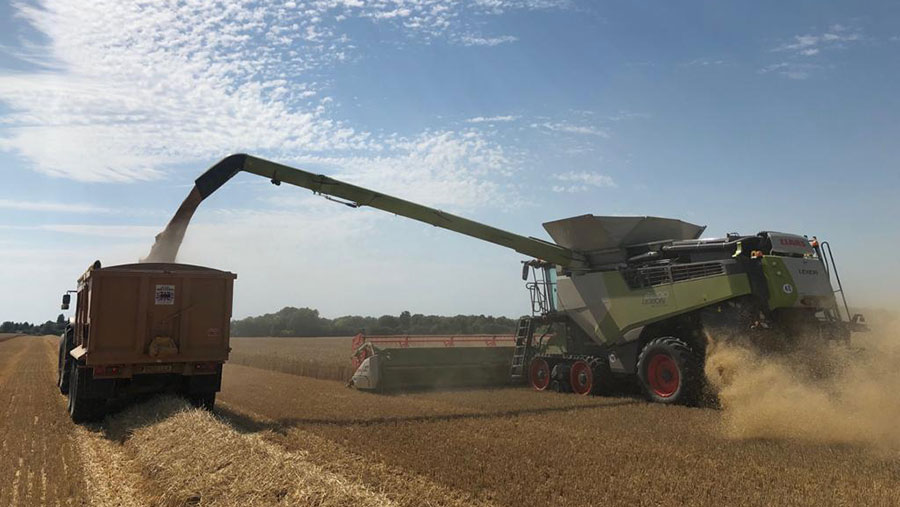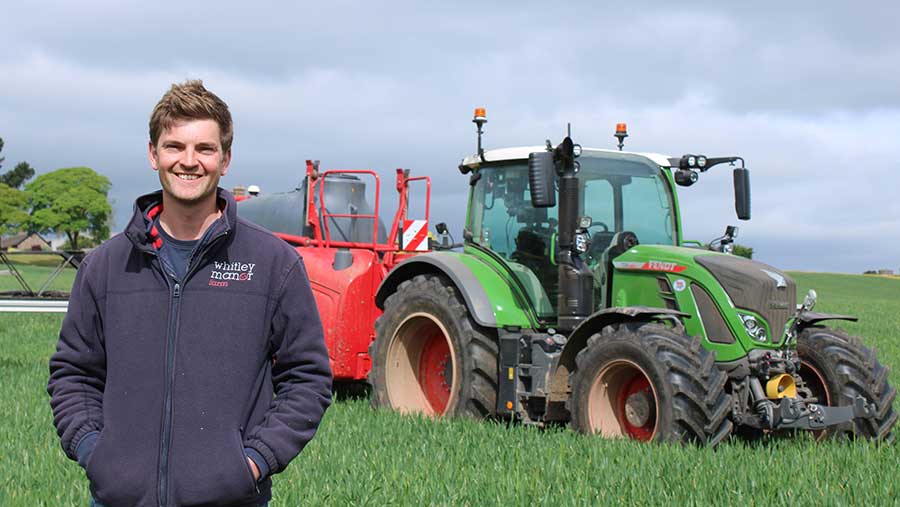Advertiser content
How 5 farmers are improving nitrogen efficiency to reduce carbon footprint
Optimising nitrogen rates is a priority on many farms for financial reasons, but it could improve the environmental footprint of farming as well.
In 2021, a year before the big increases in fertiliser prices, Bayer launched its Europe-wide Carbon programme with five farms in the UK and 22 more in six European countries.
The programme is looking at all the ways that farmers can reduce their carbon footprint in order to create a credit which can be sold to insetting schemes along the grain supply chain.
In parallel with the farm activity, Bayer is developing a digital tool that will help farmers claim rewards based on measured and verified emissions reductions.

Cultivation at Mentmore © Bayer
Carbon sequestration, fertiliser-use efficiency and fuel use are three of the ways farmers are aiming to reduce their carbon footprint.
Nitrogen fertiliser in particular offers big opportunities because of the large carbon footprint during manufacturing and emissions of nitrous oxide (N2O) after application.
In 2022, all five farmers held trials to investigate optimum nitrogen rates and improve nitrogen-use efficiency. There were interesting results, but no simple conclusions because of the complexity of crop nutrition in the field.
Most significantly, estimating the crop nitrogen requirement is inherently difficult. Soil nitrogen supply, forecast yield and recovery rate all need to be estimated when making the nutrient management plan.
Each have a huge bearing on the optimum rate for maximising yield or minimising the carbon footprint per tonne of crop.
Where yield is being limited by other factors, there is the opportunity to reduce the nitrogen rate with little yield impact. That is the easy win, but usually the challenge is more subtle.
In the trials across all five farms, the trend was that lower nitrogen rates reduced the carbon footprint, but yields were slightly lower.
Farmers need to find the point where they get diminishing returns and a higher carbon footprint from applying more nitrogen and look for ways to improve crop uptake rather than just applying more.
For example, one farm, Mentmore Park Farms, tested the use of urease inhibitors to improve uptake of liquid urea-ammonium nitrate (UAN).

Harvesting at Mentmore© Bayer
Focus 1 – improving uptake with inhibitors
Alex Morris is part of the team at Mentmore which manages 1000ha of owned land and over 2000ha in contract farming agreements.
As much of the farm sits on heavy clay, disc cultivators and deeper tines are used rotationally to solve compaction problems.
The farm has investigated no-till and low disturbance systems, but they have not worked well with the predominant soil type.
In 2022, trials in Bayer Carbon Initiative compared three alternative nitrogen programmes to the farm standard of 160kg ammonium nitrate followed by 80kg liquid urea.
|
|
Nitrogen |
Yield t/ha |
Carbon footprint kg CO2 / ha |
Carbon footprint kg CO2 / tonne |
|
Farm Standard |
160kg solid AN + 80kg liquid UAN + S |
12.6 |
1761 |
139 |
|
Trial 1 |
160kg solid AN + 80kg liquid UAN + S + Liqui-Safe |
12.8 |
1693 |
133 |
|
Trial 2 |
160kg solid AN + 60kg liquid UAN + S + Liqui-Safe |
12.7 |
1586 |
125 |
|
Trial 3 |
160kg solid AN + 120kg liquid UAN + S + Liqui-Safe |
13.1 |
1926 |
147 |
There were no statistically significant yield differences between the treatments, but the Liqui-Safe appears to have improved nitrogen uptake.
The treatment with 60kg UAN + Liqui-Safe reduced the carbon footprint by 4% and increased margin by £33/ha.
The highest nitrogen rate had 13% higher carbon footprint compared to the other treatments.
“We have been interested in using Liqui-Safe as a way to improve use uptake of liquid urea, and the trial results last season were encouraging.”
From the results, it seems that 2022 was a year when rates could be cut slightly below the farm standard, but Mr Morris is aware that this is not always the case.
“Everything varies a lot year-on-year and there are lots of things we have to estimate, for example; soil nitrogen supply and crop potential.
“It’s not possible to make an exact plan in February, you must be prepared to adapt it in season depending on conditions.”
The farm already does this to some extent with milling wheat and the decision to push for the milling premium is made in June based on price and crop condition.
Crops destined for milling receive foliar nitrogen to get them to the milling specification.
The farm is also intending to purchase a nitrogen sensor to test crops during the season to help improve decision making.
“If you have a droughty spring, that can cap potential, so you can probably reduce rates, but if the potential is there, it makes sense to apply more nitrogen and go for yield.
“We need to understand how to accurately predict when you will get a response from applying more and when you can cut rates.
“At the moment, I think many farmers apply a higher rate and get a benefit, say three out of five years. But we want to work out the two years when it isn’t worth it because of the cost and environmental benefits.”
Farm focus 2 – holistic approach to carbon
Harry Heath manages 200ha at Whitley Manor Farm and additional contracted land near Newport, Shropshire.
The home farm grows a typical range of arable crops, but he is also prepared to experiment, for example; with sunflowers in 2021.
He is keen to move the farm towards regenerative agriculture, so it was logical to accept Bayer’s invitation to join the Carbon programme.
“When we moved from conventional cultivation to direct-drilling, we saw our establishment fuel use drop from 35-40 litres/ha to 7-8 litres/ha.
“This has helped immensely because it has reduced costs allowing us to maintain margin even when yields have been low.

© Bayer
“In the early part of the transition to regenerative agriculture, it is common to see a yield drop while you wait for the soil to start cycling nutrients properly.
“Learning more about the soil is vital so we can unlock the nutrients and reduce fertiliser input.
“It will be good to put a number on carbon sequestration and greenhouse gas emissions so we can see how the changes have made a difference.
“If you claim you are doing wonderful things for carbon sinking you need to prove it, especially if it is part of a carbon credit or other payment scheme.”
What is insetting?
Carbon offsetting is well understood, such as planting trees to offset the emissions from a flight.
But the Carbon Initiative is focusing on insetting, which is similar but aims to retain any carbon savings in the same supply chain.
For example, farmers could receive an incentive from millers or bakers to reduce the emissions from wheat production.
Provided by
At Bayer Crop Science, we’re committed to supporting farmers on their journey, putting health, nutrition and sustainable food production at the very heart of what we do. As the UK’s leading agricultural innovators across seeds, crop protection products and services, we want to help shape the future of farming in a way that benefits everyone.
